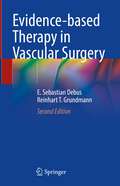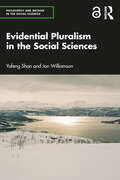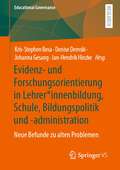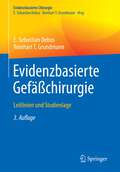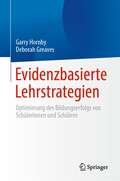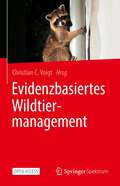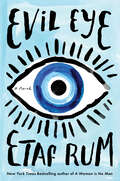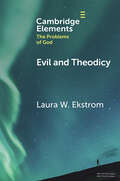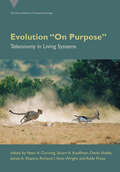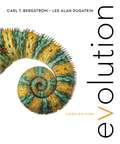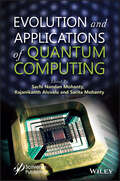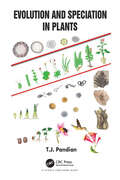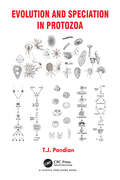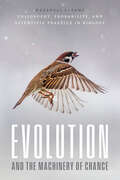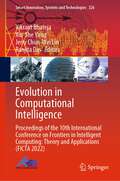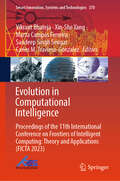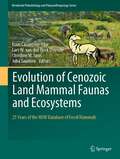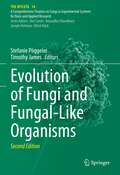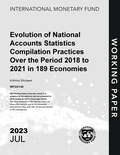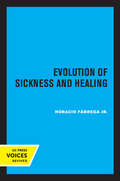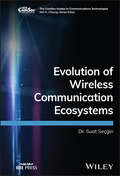- Table View
- List View
Evidence-based Practice in Nursing (Transforming Nursing Practice Series)
by Peter EllisEvidence-based practice is central to safe, high-quality and effective nursing. However, learning how to critique evidence and apply it to practice can be challenging at first. Written in clear, student-friendly language, this book builds your understanding of the terminology, theory and practice of using evidence. Learn how to evaluate different sources of evidence, apply this to your clinical decision making and, ultimately, contribute to an evidence-based culture in your workplace. Key features o Each chapter is mapped to the new 2018 NMC standards, showing how what you have learned relates to the requirements of a registered nurse o Filled with activities and student case studies to help you understand how to identify, evaluate and implement evidence-based practice o Promotes an evidence-based culture in all aspects of nursing practice, supporting your professional identity and development
Evidence-based Practice in Nursing (Transforming Nursing Practice Series)
by Peter EllisEvidence-based practice is central to safe, high-quality and effective nursing. However, learning how to critique evidence and apply it to practice can be challenging at first. Written in clear, student-friendly language, this book builds your understanding of the terminology, theory and practice of using evidence. Learn how to evaluate different sources of evidence, apply this to your clinical decision making and, ultimately, contribute to an evidence-based culture in your workplace. Key features o Each chapter is mapped to the new 2018 NMC standards, showing how what you have learned relates to the requirements of a registered nurse o Filled with activities and student case studies to help you understand how to identify, evaluate and implement evidence-based practice o Promotes an evidence-based culture in all aspects of nursing practice, supporting your professional identity and development
Evidence-based Therapy in Vascular Surgery
by E. Sebastian Debus Reinhart T. GrundmannThis book is an introduction to quality initiative for vascular surgery and medicine. It will help to introduce the best available treatment options into clinical practice. For the 21 major vascular surgical diseases, this book enables targeted evidence-based treatment choice. Basics are the most recent published treatment results of open surgery and endovascular procedures. - What do international guidelines recommend?- Which treatment results have been published in recent Cochrane reviews, structured and systematic reviews, and meta-analyses? How are they to be interpreted?- Which new randomized trials exist?- What are the results in international registries?- How do the results in centres differ from those in medium and low volume hospitals? Analysis of the data leads to well-justified differentiated treatment recommendations that can be applied directly in hospitals, clinics and practices. The book will help to raise the level of patient safety, quality of care and training of junior vascular physicians.
Evidential Pluralism in the Social Sciences (Philosophy and Method in the Social Sciences)
by Jon Williamson Yafeng ShanThis volume contends that Evidential Pluralism—an account of the epistemology of causation, which maintains that in order to establish a causal claim one needs to establish the existence of a correlation and the existence of a mechanism—can be fruitfully applied to the social sciences. Through case studies in sociology, economics, political science and law, it advances new philosophical foundations for causal enquiry in the social sciences. The book provides an account of how to establish and evaluate causal claims and it offers a new way of thinking about evidence-based policy, basic social science research and mixed methods research. As such, it will appeal to scholars with interests in social science research and methodology, the philosophy of science and evidence-based policy.
Evidentiality in Sa'dī's Poetry and Prose: A Corpus Stylistic Study (Iranian Studies)
by Behrooz Mahmoodi-Bakhtiari Masoumeh MehrabiThis study is the first to introduce evidentiality to the stylistic analysis of literary works, specifically that of the great Persian writer Sa'dī, focusing on how he used linguistic means to illustrate a real or ideational world. The authors begin by introducing the concept of evidentiality; its definition, its coding in Persian, the rationale behind evidentiality analysis, and semantic-pragmatic functions of evidentiality. The book highlights how evidentiality can be accounted for as a stylistic device to reveal the validity of a narration, as well as the author’s commitment and contribution to it. Three of Sa'dī’s major works are analyzed – Būstān, Golestān and Sonnets – using Krippendoff's frequency approach. It is argued that Sa'dī deployed an array of evidentials in his work, from direct visual evidentials in Golestān and Sonnets to heard and quoted evidentials in Būstān. To illustrate this, the book includes translations of Sa'dī’s poetry and prose. In addition, the authors consider historical and contemporary manifestations of the Persian narrative style, as well as exploring the cultural concerns of the Persian speech community. The book will appeal to general linguists, practitioners of pragmatics and stylistics, literary critics, and those interested in contrastive analysis of literature and cultural studies.
Evidenz- und Forschungsorientierung in Lehrer*innenbildung, Schule, Bildungspolitik und -administration: Neue Befunde zu alten Problemen (Educational Governance #55)
by Denise Demski Jan-Hendrik Hinzke Kris-Stephen Besa Johanna GesangMit Blick auf eine Evidenz- bzw. Forschungsorientierung vereint der Sammelband Überblicksbeiträge, empirische Studien sowie Beispiele guter Praxis auf den Ebenen Lehrer*innenbildung, Schulpraxis sowie Bildungspolitik und Bildungsadministration. Dabei werden nicht nur die jeweiligen Programmatiken hinter den Ansprüchen einer universitären Forschungsorientierung, eines datengestützten schulischen Handelns sowie einer evidenzbasierten Steuerung des Bildungssystems kritisch beleuchtet, sondern auch mögliche Ursachen einer geringen Evidenzorientierung auf den drei Ebenen identifiziert.Kapitel 10 ist unter einer Creative Commons Attribution 4.0 International License über link.springer.com frei verfügbar (Open Access).
Evidenzbasierte Gefäßchirurgie: Leitlinien und Studienlage (Evidenzbasierte Chirurgie)
by E. Sebastian Debus Reinhart T. GrundmannDas bewährte Konzept der „Evidenzbasierten Gefäßchirurgie“ wurde auch für die 3. Auflage beibehalten: für die 21 wichtigsten gefäßchirurgischen Indikationsgebiete werden die Empfehlungen der nationalen und internationalen Leitlinien sowie die Ergebnisse von Metaanalysen, Cochrane-Reviews, randomisierten Studien und Registererhebungen systematisch und übersichtlich zusammengestellt.Dabei konzentriert sich die 3. Auflage auf den neuesten Wissens- und Diskussionsstand: auf der Basis einer umfassenden Literaturrecherche sind alle wichtigen Publikationen berücksichtigt, die seit Erscheinen der 2. Auflage in den Jahren 2018 bis ins Jahr 2022 erschienen sind, darunter 23 neue oder aktualisierte Leitlinien. Dem Leser wird damit nicht nur die Evidenz, sondern auch der neueste Wissens- und Diskussionsstand vermittelt.Zusätzlich wurde die 3. Auflage um ein Kapitel zum Thema Ulcus cruris erweitert, und erstmalig wurde für wichtige Kapitel ein zusätzlicher Abschnitt zum perioperativen Management eingefügt.
Evidenzbasierte Lehrstrategien: Optimierung des Bildungserfolgs von Schülerinnen und Schülern
by Garry Hornby Deborah GreavesDieses Buch befasst sich mit evidenzbasierten Praktiken, die einen effektiven Unterricht ermöglichen, um einen optimalen Bildungserfolg für Schüler zu gewährleisten. Es identifiziert Schlüsselstrategien, die auf umfangreichen Forschungsergebnissen basieren, welche ihre Wirksamkeit bei der Verbesserung der Schülerergebnisse bestätigen. Das Buch bietet Lehrkräften einen Leitfaden zur Unterscheidung zwischen Strategien, die evidenzbasiert sind, und solchen, für die es nur wenige oder gar keine Belege gibt. Es beschreibt gängige Unterrichtsstrategien, die häufig in Schulen eingesetzt werden, obwohl ihre Wirksamkeit kaum belegt ist. Darüber hinaus werden in dem Buch acht wichtige evidenzbasierte Unterrichtspraktiken genannt, die von den Lehrkräften direkt umgesetzt werden können, die theoretischen und forschungsbasierten Grundlagen für jede dieser Strategien erläutert, und es werden Leitlinien für Sonder- und allgemeinbildende Lehrkräfte gegeben, wie sie diese Strategien am effektivsten anwenden können, mit Links zu Videobeispielen für ihre Anwendung im Unterricht. Der Text untersucht auch häufige Hindernisse für den Einsatz evidenzbasierter Praktiken in Schulen. Es werden die Auswirkungen auf die Lehrerausbildung untersucht, wobei der Schwerpunkt auf der Ausbildung von Pädagogen liegt, damit sie evidenzbasierte Strategien erkennen und effektiv umsetzen können, wobei diejenigen vermieden werden, die nicht evidenzbasiert sind, selbst wenn sie in den Schulen beliebt sind. „Evidenzbasierte Lehrstrategien“ ist ein unverzichtbares Nachschlagewerk für Forscher, Fachleute und Studenten der pädagogischen Psychologie, der Kinder- und Schulpsychologie und der Sozialarbeit, die daran interessiert sind, wirksame Lehrmethoden kennenzulernen und umzusetzen, die das Engagement der Schüler und ihre schulischen Leistungen verbessern, das sozial-emotionale Lernen stärken und die Schulabbrecherquote senken.
Evidenzbasiertes Wildtiermanagement
by Christian C. Voigt<p>Diese Open Access Publikation hat das Spannungsfeld zwischen Menschen und Wildtieren, die sich ihren Lebensraum teilen, zum Thema. Dies kann zu Konflikten führen, die wirksame Managementmaßnahmen erfordern. Einerseits müssen anthropogene Störfaktoren für bedrohte und geschützte Wildtiere reduziert und Ausgleichsmaßnahmen entwickelt werden, damit sich die Bestände erholen. Andererseits stellt sich die Frage, ob die Populationen einiger Wildtierarten reguliert werden müssen, um Schäden für Mensch und Natur abzuwenden.<p> <p>Welche konkreten Maßnahmen ergriffen werden, sollte aus deren Notwendigkeit und nachgewiesener Wirksamkeit abgeleitet werden. Hierfür sind Erkenntnisse aus Forschung und praktischem Wildtiermanagement erforderlich.<p> <p>Führende Wildtierexperten stellen den jeweiligen Wissensstand in ihrer Fachdisziplin dar oder schlagen neue konzeptionelle Wege vor, um innovative Managementmaßnahmen zu erproben. Das Buch richtet sich sowohl an Forschende als auch an Fachleute und Beschäftigte von Behörden und Naturschutzverbänden.<p>
Evidenzbasiertes Wildtiermanagement
by Christian C. VoigtDiese Open Access Publikation hat das Spannungsfeld zwischen Menschen und Wildtieren, die sich ihren Lebensraum teilen, zum Thema. Dies kann zu Konflikten führen, die wirksame Managementmaßnahmen erfordern. Einerseits müssen anthropogene Störfaktoren für bedrohte und geschützte Wildtiere reduziert und Ausgleichsmaßnahmen entwickelt werden, damit sich die Bestände erholen. Andererseits stellt sich die Frage, ob die Populationen einiger Wildtierarten reguliert werden müssen, um Schäden für Mensch und Natur abzuwenden. Welche konkreten Maßnahmen ergriffen werden, sollte aus deren Notwendigkeit und nachgewiesener Wirksamkeit abgeleitet werden. Hierfür sind Erkenntnisse aus Forschung und praktischem Wildtiermanagement erforderlich. Führende Wildtierexperten stellen den jeweiligen Wissensstand in ihrer Fachdisziplin dar oder schlagen neue konzeptionelle Wege vor, um innovative Managementmaßnahmen zu erproben. Das Buch richtet sich sowohl an Forschende als auch an Fachleute und Beschäftigte von Behörden und Naturschutzverbänden.
Evil Eye: A Novel
by Etaf RumAn NPR Best Book of the Year“A moving meditation on motherhood, inter-generational trauma and how surface appearances often obscure a deeper truth. . . . A stunning second novel from a writer who set the bar very high with her first!”—Tara Conklin, New York Times bestselling author of The Last Romantics and Community BoardThe acclaimed New York Times bestselling author of A Woman Is No Man returns with a striking exploration of the expectations of a Palestinian-American woman, the meaning of a fulfilling life, and the ways our unresolved pasts affect our presents."After Yara is placed on probation at work for fighting with a racist coworker, her Palestinian mother claims the provocation and all that’s come after were the result of a family curse. While Yara doesn’t believe in old superstitions, she finds herself unpacking her strict, often volatile childhood growing up in Brooklyn, looking for clues as to why she feels so unfulfilled in a life her mother could only dream of. Etaf Rum’s follow-up to her 2019 debut, A Woman Is No Man, is a complicated mother-daughter drama that looks at the lasting effects of intergenerational trauma and what it takes to break the cycle of abuse." —Time magazine, "The Most Anticipated Books of the Year"
Evil and Theodicy (Elements in the Problems of God)
by Laura W. EkstromSuffering is ubiquitous. Quests to make sense of it in relation to the existence of God – and to find meaning in our lives in the face of it – are significant aspects of the human experience. Evil and Theodicy motivates the project of theodicy by examining arguments rooted in evil against God's existence and by critically assessing the response of skeptical theism. Ekstrom explores eight different lines of theodicy. She argues that, even if the prospects for theodicy are dim with respect to defending the rationality of theistic belief in light of suffering, nonetheless, work in theodicies is practically useful.
Evolution "On Purpose": Teleonomy in Living Systems (Vienna Series in Theoretical Biology)
by Peter A. Corning, et al.A unique exploration of teleonomy—also known as &“evolved purposiveness&”—as a major influence in evolution by a broad range of specialists in biology and the philosophy of science.The evolved purposiveness of living systems, termed &“teleonomy&” by chronobiologist Colin Pittendrigh, has been both a major outcome and causal factor in the history of life on Earth. Many theorists have appreciated this over the years, going back to Lamarck and even Darwin in the nineteenth century. In the mid-twentieth century, however, the complex, dynamic process of evolution was simplified into the one-way, bottom-up, single gene-centered paradigm widely known as the modern synthesis. In Evolution &“On Purpose,&” edited by Peter A. Corning, Stuart A. Kauffman, Denis Noble, James A. Shapiro, Richard I. Vane-Wright, and Addy Pross, some twenty theorists attempt to modify this reductive approach by exploring in depth the different ways in which living systems have themselves shaped the course of evolution.Evolution &“On Purpose&” puts forward a more inclusive theoretical synthesis that goes far beyond the underlying principles and assumptions of the modern synthesis to accommodate work since the 1950s in molecular genetics, developmental biology, epigenetic inheritance, genomics, multilevel selection, niche construction, physiology, behavior, biosemiotics, chemical reaction theory, and other fields. In the view of the authors, active biological processes are responsible for the direction and the rate of evolution. Essays in this collection grapple with topics from the two-way &“read-write&” genome to cognition and decision-making in plants to the niche-construction activities of many organisms to the self-making evolution of humankind. As this collection compellingly shows, and as bacterial geneticist James Shapiro emphasizes, &“The capacity of living organisms to alter their own heredity is undeniable.&”
Evolution (Third Edition)
by Lee Alan Dugatkin Carl T. BergstromThe most current introduction to evolutionary biology, with an emphasis on anthropogenic evolution and data literacy. A thorough and current introduction to evolutionary biology reinforced by tools that improve learning. Every chapter has been updated to provide a more focused, accessible introduction to core topics reflecting exciting new research, anthropogenic evolution examples, and increased emphasis on building data literacy. These emphases are reinforced by InQuizitive, which was revised and expanded to include more questions that involve interpreting evolutionary data and engaging with contemporary research. This purchase offers access to the digital ebook only.
Evolution and Applications of Quantum Computing
by Sachi Nandan Mohanty Rajanikanth Aluvalu Sarita MohantyEVOLUTION and APPLICATIONS of QUANTUM COMPUTING The book is about the Quantum Model replacing traditional computing’s classical model and gives a state-of-the-art technical overview of the current efforts to develop quantum computing and applications for Industry 4.0. A holistic approach to the revolutionary world of quantum computing is presented in this book, which reveals valuable insights into this rapidly emerging technology. The book reflects the dependence of quantum computing on the physical phenomenon of superposition, entanglement, teleportation, and interference to simplify difficult mathematical problems which would have otherwise taken years to derive a definite solution for. An amalgamation of the information provided in the multiple chapters will elucidate the revolutionary and riveting research being carried out in the brand-new domain encompassing quantum computation, quantum information and quantum mechanics. Each chapter gives a concise introduction to the topic. The book comprises 18 chapters and describes the pioneering work on the interaction between artificial intelligence, machine learning, and quantum computing along with their applications and potential role in the world of big data. Subjects include: Combinational circuits called the quantum multiplexer with secured quantum gate (CSWAP); Detecting malicious emails and URLs by using quantum text mining algorithms to distinguish between phishing and benign sites; Quantum data traffic analysis for intrusion detection systems; Applications of quantum computation in banking, netnomy and vehicular ad-hoc networks, virtual reality in the education of autistic children, identifying bacterial diseases and accelerating drug discovery; The critical domain of traditional classical cryptography and quantum cryptography. Audience The book will be very useful for researchers in computer science, artificial intelligence and quantum physics as well as students who want to understand the history of quantum computing along with its applications and have a technical state-of-the-art overview.
Evolution and Speciation in Plants
by T.J. PandianPlants are autotrophs and sessile, while animals are heterotrophs and motile. Sessility has imposed on plants 94% hermaphroditism, 23% selfing, 3% polyploidization and 39% clonality, in comparison to 19 and
Evolution and Speciation in Protozoa
by T.J. PandianThe polyphyletic Protozoa have explored the possibility of performing almost all metazoan functions with a few subcellular organelles. Their unicellularity and structural simplicity have (i) limited diversity to 32,950 species, (ii) restricted spatial distribution to aquatic habitats (94%, against 15% in Metazoa), (iii) demonstrated the ubiquitous dominance of clonality, (iv) reduced sexualization in 50% species, (v) facilitated the use of vegetative gametes in 40% species and (vi) secondary loss of sex in 10% species. With the fastest multiplication rates, i.e. once every 6-60 hours, they occur in high densities of 105-106 cell/ml. Their diverse and complicated life cycles are described in 30 types. Being risky, the cycle involves two hosts in clonality > hermaphroditism > motility. Motility ranges from 2-3 μm for Rhizopoda to 400-2,000 μm for Ciliophora. Not surprisingly, 6,800 species of arcellinids, filosians and formainifers are testated or shelled. Within 1,229 sessile species, the peritrichid and suctorian ciliates are better adapted to coloniality. Unlike those of many Metazoa, the protozoan cyst is a dynamic stage, in which clonal or sexual reproduction occurs. Over 81% protozoans encyst, as it ensures (i) 90% survival during unfavorable conditions (against 15 in 12% non-encysted protozoans), (ii) genome transfer through generations, (iii) dispersal into new habitats and (iv) transmission to new hosts. Their mean body size ranges from 2 μm to 2 mm – a range over 1,000-times – only 8% aquatic metazoans cover a similar size range. In comparison to 77% macrophagy in Metazoa, only 46% protozoans are macrophagous predators. Within motile microphagy, protozoans filter 3-2 times smaller food particle at 50% cheaper clearance cost. This efficiency has expanded microphagy to 15% in protozoans, against 3% in Metazoa. Hence, their turnover rate in trophic dynamics is twice faster than that of metazoans. Foraminifers serve as ecological sensitive indicators in petroleum exploration and rise in sea level. For the first time, incidences of clonality and meiosis as well as symbiosis and parasitism have been shown to hint at the origin and evolution of different protozoan taxonomic groups during the geological past.
Evolution and the Machinery of Chance: Philosophy, Probability, and Scientific Practice in Biology
by Marshall AbramsAn innovative view of the role of fitness concepts in evolutionary theory. Natural selection is one of the factors responsible for changes in biological populations. Some traits or organisms are fitter than others, and natural selection occurs when there are changes in the distribution of traits in populations because of fitness differences. Many philosophers of biology insist that a trait’s fitness should be defined as an average of the fitnesses of individual members of the population that have the trait. Marshall Abrams argues convincingly against this widespread approach. As he shows, it conflicts with the roles that fitness is supposed to play in evolutionary theory and with the ways that evolutionary biologists use fitness concepts in empirical research. The assumption that a causal kind of fitness is fundamentally a property of actual individuals has resulted in unnecessary philosophical puzzles and years of debate. Abrams came to see that the fitnesses of traits that are the basis of natural selection cannot be defined in terms of the fitnesses of actual members of populations, as philosophers of biology often claim. Rather, it is an overall population-environment system—not actual, particular organisms living in particular environmental conditions—that is the basis of trait fitnesses. Abrams argues that by distinguishing different classes of fitness concepts and the roles they play in the practice of evolutionary biology, we can see that evolutionary biologists’ diverse uses of fitness concepts make sense together and are consistent with the idea that fitness differences cause evolution. Abrams’s insight has broad significance, for it provides a general framework for thinking about the metaphysics of biological evolution and its relations to empirical research. As such, it is a game-changing book for philosophers of biology, biologists who want deeper insight into the nature of evolution, and anyone interested in the applied philosophy of probability.
Evolution in Computational Intelligence: Proceedings of the 10th International Conference on Frontiers in Intelligent Computing: Theory and Applications (FICTA 2022) (Smart Innovation, Systems and Technologies #326)
by Xin-She Yang Vikrant Bhateja Jerry Chun-Wei Lin Ranjita DasThe book presents the proceedings of the 10th International Conference on Frontiers of Intelligent Computing: Theory and Applications (FICTA 2022), held at NIT Mizoram, Aizawl, Mizoram, India during 18 – 19 June 2022. Researchers, scientists, engineers, and practitioners exchange new ideas and experiences in the domain of intelligent computing theories with prospective applications in various engineering disciplines in the book. These proceedings are divided into two volumes. It covers broad areas of information and decision sciences, with papers exploring both the theoretical and practical aspects of data-intensive computing, data mining, evolutionary computation, knowledge management and networks, sensor networks, signal processing, wireless networks, protocols and architectures. This volume is a valuable resource for postgraduate students in various engineering disciplines.
Evolution in Computational Intelligence: Proceedings of the 11th International Conference on Frontiers of Intelligent Computing: Theory and Applications (FICTA 2023) (Smart Innovation, Systems and Technologies #370)
by Xin-She Yang Vikrant Bhateja Carlos M. Travieso-Gonzalez Marta Campos Ferreira Sandeep Singh SengarThe book presents the proceedings of the 11th International Conference on Frontiers of Intelligent Computing: Theory and Applications (FICTA 2023), held at Cardiff School of Technologies, Cardiff Metropolitan University, Cardiff, Wales, UK, during April 11–12, 2023. Researchers, scientists, engineers, and practitioners exchange new ideas and experiences in the domain of intelligent computing theories with prospective applications in various engineering disciplines in the book. This book is divided into two volumes. It covers broad areas of information and decision sciences, with papers exploring both the theoretical and practical aspects of data-intensive computing, data mining, evolutionary computation, knowledge management and networks, sensor networks, signal processing, wireless networks, protocols, and architectures. This book is a valuable resource for postgraduate students in various engineering disciplines.
Evolution of Cenozoic Land Mammal Faunas and Ecosystems: 25 Years of the NOW Database of Fossil Mammals (Vertebrate Paleobiology and Paleoanthropology)
by Christine M. Janis Isaac Casanovas-Vilar Lars W. van den Hoek Ostende Juha SaarinenThis volume presents an array of different case studies which take as primary material data sourced from the NOW (‘New and Old Worlds’) database of fossil mammals. The NOW database was one of the very first large paleobiological databases, and since 1996 it has been expanded from including mainly Neogene European land mammals to cover the entire Cenozoic at a global scale. In the last two decades the number of works that are based in the use of huge databases to explore ecological and evolutionary questions has increased exponentially, and even though the importance of big data in paleobiological research has been outlined in selected chapters of general works, no volume has appeared before this one which solely focuses on the databases as a primary source in reconstructing the past. The purpose of this book is to provide an illustrative volume showing the importance of big data in paleobiological research, and presenting a broad array of unpublished examples and case studies. The book is mainly aimed to professional palaeobiologists working with Cenozoic land mammals, but the scope of the book is broad enough to fit the interest for evolutionary biologists, paleoclimatologists and paleoecologists.The volume is divided in four parts. The first part includes two chapters on the development of large paleobiological databases, providing a first-hand account on the logic and the functioning of these databases. This is a much-needed perspective which is ignored by most researchers and users of such databases and, even if centered in the NOW database, the lessons that can be learned from this part can be extended to other examples. After this introductory part, the body of the book follows and is divided into three parts: patterns in regional faunas; large scale patterns and processes; and ecological, biogeographical and evolutionary patterns of key taxa. Each chapter is written by well-known specialists in the field, with some participation of members of the NOW advisory board. The array of selected mammal taxa ranges from carnivores, equids, ruminants and rodents to the genus Homo. The topics studied also include the diversification and radiation of major clades, large-scale paleobiogeographical patterns, the evolution of ecomorphological patterns and paleobiological problems such as evolution of body size or species longevity. In most cases the results are discussed in relation to protracted environmental or paleogeographic changes.
Evolution of Fungi and Fungal-Like Organisms (The Mycota #14)
by Stefanie Pöggeler Timothy JamesSequence analyses of numerous fungal genomes over the past two decades have provided us with extensive insights into the phylogenetic relationships of fungi and the distribution of genes and their inferred functions, across the fungal kingdom. It is now possible to answer questions about the origin of the fungal kingdom and fungal evolution with an analytical precision that was not possible before.This fully revised and updated 2nd edition of The Mycota, Vol. 14, addresses major aspects of fungal evolution. The book is divided into four sections covering the following main topics:• Evolutionary roots of fungi• Evolution of pathogenic strategies• Evolution of mutualistic interactions• Evolution of metabolism and development in fungiFungi are among the oldest eukaryotic groups in the living world. The aim of this book is to better understand the history and importance of fungi, as well as the characteristics that distinguish them from their sister group, the metazoans, and other fungus-like groups such as the slime molds and oomycetes. Many fungal species are important pathogens of animals and plants and have distinct but parallel pathogenicity strategies. Mutualistic interactions of fungi with other organisms are crucial for their survival in different ecological niches and have a great influence on their evolution and the design of their genomes. Metabolism is one of the most important features of life, and the diversity of metabolic processes is best understood by considering evolution. Studies of fungal metabolism have traditionally focused on metabolites of particular interest, namely mycotoxins, pathogenicity factors, antibiotics, and other compounds with interspecific activity. This volume will be of great interest to mycologists, evolutionary biologists, and fungal geneticists, as well as to lecturers and students of microbiology and mycology.
Evolution of National Accounts Statistics Compilation Practices Over the Period 2018 to 2021 in 189 Economies
by SilungweA report from the International Monetary Fund.
Evolution of Sickness and Healing
by Horacio Fábrega Jr.Evolution of Sickness and Healing is a theoretical work on the grand scale, an original synthesis of many disciplines in social studies of medicine. Looking at human sickness and healing through the lens of evolutionary theory, Horacio Fàbrega, Jr. presents not only the vulnerability to disease and injury but also the need to show and communicate sickness and to seek and provide healing as innate biological traits grounded in evolution. This linking of sickness and healing, as inseparable facets of a unique human adaptation developed during the evolution of the hominid line, offers a new vantage point from which to examine the institution of medicine. To show how this complex, integrated adaptation for sickness and healing lies at the root of medicine, and how it is expressed culturally in relation to the changing historical contingencies of human societies, Fàbrega traces the characteristics of sickness and healing through the early and later stages of social evolution. Besides offering a new conceptual structure and a methodology for analyzing medicine in evolutionary terms, he shows the relevance of this approach and its implications for the social sciences and for medical policy. Health scientists and medical practitioners, along with medical historians, economists, anthropologists, and sociologists, now have the opportunity to consider every essential aspect of medicine within an integrated framework. This title is part of UC Press's Voices Revived program, which commemorates University of California Press's mission to seek out and cultivate the brightest minds and give them voice, reach, and impact. Drawing on a backlist dating to 1893, Voices Revived makes high-quality, peer-reviewed scholarship accessible once again using print-on-demand technology. This title was originally published in 1997.
Evolution of Wireless Communication Ecosystems (The ComSoc Guides to Communications Technologies)
by Suat SecginEvolution of Wireless Communication Ecosystems Understand a world transformed by wireless communication with this groundbreaking guide Since the advent of the internet, few technologies have proven more transformative than wireless communication. Never have we lived in a more comprehensively connected world, with the cloud and the coming sixth generation (6G) of wireless technology creating a vast and interconnected communications infrastructure. Global citizens of this newly interconnected reality are grappling like never before with its many challenges. Evolution of Wireless Communication Ecosystems provides readers with a history of wireless communication and a thorough overview of emerging frontiers. It traces wireless communication from the first generation through to the current fifth before surveying the current state of wireless technology and the ongoing research into 6G. The result is a book that understands wireless communication for the first time as an ecosystem, endlessly interconnected, growing, and boundlessly complex, but made intelligible by this highly readable introduction. Readers will also find: Detailed explanations of the journey starting from 1G to 6G Descriptions the infrastructure of 4G, 5G, and 6G systems, this all-connected communication ecosystem, the sub-components of this ecosystem, and the relationship among them Depictions of events seen in the capillaries of the communication echo system that show switching techniques, modulation, and multiplexing techniques Coverage of access techniques, protocols, the methods used in M2M and IoT connections at the endpoints, and security issues that show how they are an integral part of wireless communication infrastructure Evolution of Wireless Communication Ecosystems from 1G to 6G is an essential reference for wireless and telecommunications professionals, as well as researchers interested in 6G or other emerging wireless technologies.

